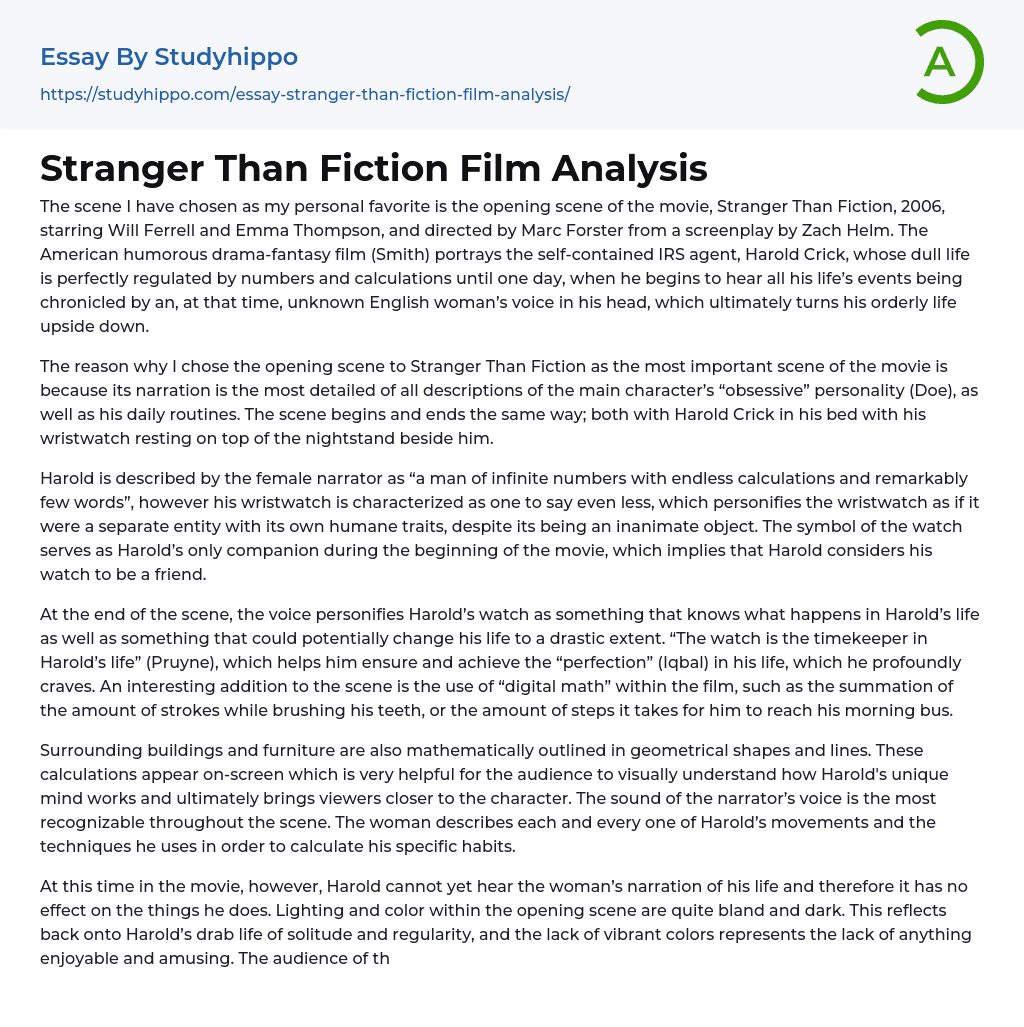The scene I have chosen as my personal favorite is the opening scene of the movie, Stranger Than Fiction, 2006, starring Will Ferrell and Emma Thompson, and directed by Marc Forster from a screenplay by Zach Helm. The American humorous drama-fantasy film (Smith) portrays the self-contained IRS agent, Harold Crick, whose dull life is perfectly regulated by numbers and calculations until one day, when he begins to hear all his life’s events being chronicled by an, at that time, unknown English woman’s voice in his head, which ultimately turns his orderly life upside down.
The reason why I chose the opening scene to Stranger Than Fiction as the most important scene of the movie is because its narration is the most detailed of all descriptions of the main character’s “obsessive” personality (Doe
...), as well as his daily routines. The scene begins and ends the same way; both with Harold Crick in his bed with his wristwatch resting on top of the nightstand beside him.
Harold is described by the female narrator as “a man of infinite numbers with endless calculations and remarkably few words”, however his wristwatch is characterized as one to say even less, which personifies the wristwatch as if it were a separate entity with its own humane traits, despite its being an inanimate object. The symbol of the watch serves as Harold’s only companion during the beginning of the movie, which implies that Harold considers his watch to be a friend.
At the end of the scene, the voice personifies Harold’s watch as something that knows what happens in Harold’s life as well as something that coul
potentially change his life to a drastic extent. “The watch is the timekeeper in Harold’s life” (Pruyne), which helps him ensure and achieve the “perfection” (Iqbal) in his life, which he profoundly craves. An interesting addition to the scene is the use of “digital math” within the film, such as the summation of the amount of strokes while brushing his teeth, or the amount of steps it takes for him to reach his morning bus.
Surrounding buildings and furniture are also mathematically outlined in geometrical shapes and lines. These calculations appear on-screen which is very helpful for the audience to visually understand how Harold's unique mind works and ultimately brings viewers closer to the character. The sound of the narrator’s voice is the most recognizable throughout the scene. The woman describes each and every one of Harold’s movements and the techniques he uses in order to calculate his specific habits.
At this time in the movie, however, Harold cannot yet hear the woman’s narration of his life and therefore it has no effect on the things he does. Lighting and color within the opening scene are quite bland and dark. This reflects back onto Harold’s drab life of solitude and regularity, and the lack of vibrant colors represents the lack of anything enjoyable and amusing. The audience of the scene immediately recognizes that Harold Crick is not a man who has much fun, but instead lives a life purely based on rules and regulations, however, according to the narrator, this was all about to change.
- Allegory essays
- Alliteration essays
- Comedy essays
- Comic book essays
- Drama essays
- Dystopia essays
- Fairy Tale essays
- Fantasy essays
- Fiction essays
- Ghost essays
- Gothic Fiction essays
- Gothic Literature essays
- Irony essays
- Legend essays
- Memoir essays
- Novel essays
- Poetry essays
- Satire essays
- Science Fiction essays
- Short Story essays
- The western essays
- Tragedy essays
- Witchcraft essays




